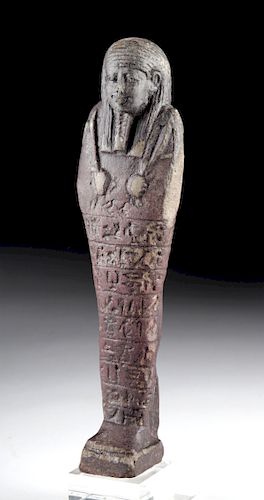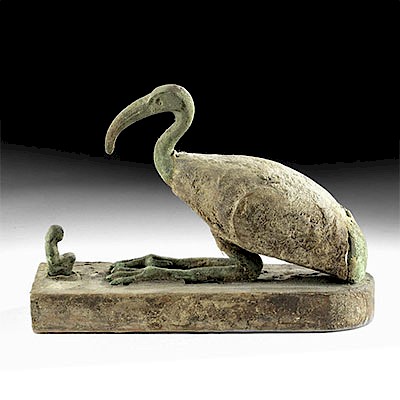Egyptian Ptolemaic Faience Ushabti w/ Purple Glaze
Lot 9a
About Seller
Artemis Fine Arts
686 S Taylor Ave, Ste 106
Louisville, CO 80027
United States
Selling antiquities, ancient and ethnographic art online since 1993, Artemis Gallery specializes in Classical Antiquities (Egyptian, Greek, Roman, Near Eastern), Asian, Pre-Columbian, African / Tribal / Oceanographic art. Our extensive inventory includes pottery, stone, metal, wood, glass and textil...Read more
Estimate:
$4,000 - $6,000
Absentee vs Live bid
Two ways to bid:
- Leave a max absentee bid and the platform will bid on your behalf up to your maximum bid during the live auction.
- Bid live during the auction and your bids will be submitted real-time to the auctioneer.
Bid Increments
| Price | Bid Increment |
|---|---|
| $0 | $25 |
| $300 | $50 |
| $1,000 | $100 |
| $2,000 | $250 |
| $5,000 | $500 |
| $10,000 | $1,000 |
| $20,000 | $2,500 |
| $50,000 | $5,000 |
| $100,000 | $10,000 |
| $200,000 | $20,000 |
About Auction
By Artemis Fine Arts
Oct 31, 2019
Set Reminder
2019-10-31 10:00:00
2019-10-31 10:00:00
America/New_York
Bidsquare
Bidsquare : Fine Antiquities, Asian, Ethnographic Art
https://www.bidsquare.com/auctions/artemis-gallery/fine-antiquities-asian-ethnographic-art-4581
Our Halloween Day auction features classical antiquities, ancient and ethnographic art from cultures encompassing the globe, plus fine art. Artemis Fine Arts info@artemisfinearts.com
Our Halloween Day auction features classical antiquities, ancient and ethnographic art from cultures encompassing the globe, plus fine art. Artemis Fine Arts info@artemisfinearts.com
- Lot Description
Egypt, Ptolemaic Period, ca. 332 to 30 BCE. A large and exceptionally rare mold-formed ushabti made from faience and covered in a wine-hued purple glaze. The figure stands in mummiform with fused legs atop an integral rectangular plinth, holds the symbolic pick and hoe in arms crossed atop the chest, and has a small seed bag draped over the left shoulder. The charming visage is composed of almond-shaped eyes with elongated canthi, a broad nose above full lips, cupped ears, and a plaited false beard, all beneath the striated tripartite wig. Nine lines of inscribed hieroglyphic text wrap around the legs and front of the body, though a few characters above the topmost line are perhaps associated with the name. Though untranslated, the inscription would provide the name and title of the deceased along with an invocation from Chapter 6 of the Egyptian Book of the Dead (or Book of Going Forth by Day). Size: 2.2" W x 8.4" H (5.6 cm x 21.3 cm); 9.4" H (23.9 cm) on included custom stand.
Ushabti were placed in tombs as grave goods, created to do manual labor for the deceased in the afterlife. As a result, they are frequently depicted with arms crossed, holding hoes and baskets. By the Third Intermediate period, this practice had become so necessary and elaborate that some tombs contained one worker for every day of the year and thirty-six overseers, each responsible for ten laborers. Workers like this one are from that period of enormous proliferation, and are some of our best surviving insights into ancient Egyptian funerary practices.
Provenance: ex-private Arizona, USA collection, acquired in the 1980s
All items legal to buy/sell under U.S. Statute covering cultural patrimony Code 2600, CHAPTER 14, and are guaranteed to be as described or your money back.
A Certificate of Authenticity will accompany all winning bids.
We ship worldwide and handle all shipping in-house for your convenience.
#146177Small area of repair to back pillar, with stabilization to some fissures, and with small chips and light adhesive residue along break lines. Minor abrasions and nicks to base, legs, body, and head, with softening to finer details and inscribed hieroglyphic text, and fading to original glaze pigmentation. Nice earthen deposits throughout.Condition
- Shipping Info
-
All shipping is handled in-house for your convenience. Your invoice from Artemis Gallery will include shipping calculation instructions. If in doubt, please inquire BEFORE bidding for estimated shipping costs for individual items.
-
- Buyer's Premium



 EUR
EUR CAD
CAD AUD
AUD GBP
GBP MXN
MXN HKD
HKD CNY
CNY MYR
MYR SEK
SEK SGD
SGD CHF
CHF THB
THB














